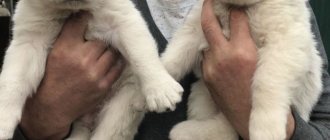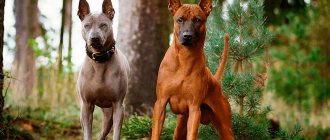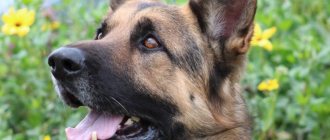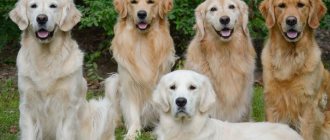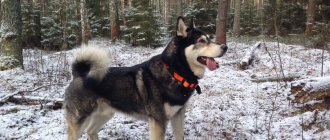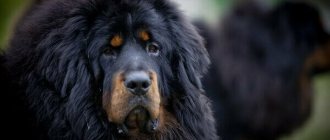Alabai is a guard dog, this is how it happened historically. It is believed that this breed appeared several thousand years ago from the mixing of nomadic herding dogs with Tibetan mastiffs and Mongolian shepherd dogs. The Alabai dog breed was used to guard herds, caravans and homes. This smart animal can become a loyal and devoted friend.
Alabai is a guard dog, it happened historically
History of the origin of the breed
The Central Asian Shepherd has existed for about three thousand years; according to some archaeological sources, the age of the breed can reach 6 thousand years.
- Nomadic tribes played a role in the origin of Alabai. Their pastures required powerful protection from attacks by predatory animals.
- Having settled over fairly vast territories, from the Caspian Sea to the Tibetan Plateau, people contributed to the emergence of the first Central Asians, strong and resilient, who could easily cope with a wolf.
- The breed was formed in natural conditions, without any human intervention.
The Central Asian Shepherd Dog breed contains the genes of their ancestors from ancient Asia and the dogs that were used in Mesopotamia for fighting. The breed is related to the Tibetan mastiffs. Shepherd dogs of ancient nomadic peoples are also directly related to this breed.
Interesting: Ears and tail docking for this breed began thousands of years ago.
“Central Asian Shepherd Dog” is the official name of this breed in Russia. Since 1989, the description of the Central Asian Shepherd Dog breed has been enshrined in the standard under the number FCI No. 335. And for a long time no changes were made to the adopted standard.
Purposeful study of the Central Asian Shepherd Dog in the USSR began in the 60s of the 20th century. The formidable appearance of the breed was supposed to be used in the protection of strategically important objects; the heavy nature of the dogs made this task impossible.
Application
The Central Asian Shepherd Dog is a multifunctional breed, but its watchdog qualities are most clearly expressed. Currently, these dogs are used for protection and security.
- farm animals and control over them in grazing;
- entrusted objects and territories, including industrial zones;
- private households and their owners.
Some varieties of alabai are used for hunting. In the past, representatives of this breed were exploited as a draft force, and were also trained as fighting dogs to participate in canine gladiatorial tournaments.
Description of the breed, characteristics (photo of the dog)
The Central Asian Shepherd is distinguished by its harmonious body structure. The Asian is very muscular, the withers are high. The ears are small relative to the body. Ear set is low. The head is large, with a square muzzle.
The life cycle of the breed is long - up to 15 years.
According to the standard, an adult:
- A male at the withers is about 80 cm tall and weighs about 70 kg;
- Bitches reach 70 cm, weight 60 kg.
The Asian has a coarse coat about 8 cm long and a thick undercoat up to 4 cm. A massive mane forms on the neck. The tail is thick, high set.
- The color of the shepherd dog can be black and white, red, gray, piebald, brindle, and speckled.
- In addition, there are other colors that are popular in other countries.
- In the photo of the Central Asian Shepherd you can see all the variety of colors of the breed.
- The eyes are widely spaced, not very large, elongated. The color of the pupils depends on the color of the coat.
- The tip of the nose is black, but some colors (fawn and white) have a light color.
- The upper lips should cover the lower jaw and have black pigmentation.
Tiger alabai
These dogs have fur that is gray, brown or yellowish-golden in color. On the upper part of the body (back, neck, croup) and limbs there are dark transverse stripes that close into rings in the chest and abdomen. In some individuals, the main coat color is diluted with white spots.
Many brindle-colored dogs have dark, almost black fur on their faces, which makes it appear as if the dog is wearing a mask.
Alabai brindle color
Character and behavior
Of course, before you decide to get a dog of this breed, you need to read a lot of literature and talk with knowledgeable people. And it’s best if it’s a canine specialist. Answer the question: “Can I cope with such a big dog?”
The character of today's Asian Shepherd is not simple. And behavior often reflects how involved the dog's owner is in raising the dog.
- Alabai will not simply follow commands, he is too smart for that.
- First, the dog evaluates the need for the command, and then executes it (if necessary).
- The character is very strong, and you need to start raising an Asian as early as possible.
Advice: A dog of this breed should not be hit or scolded, otherwise it will be a disaster. It is best to use the services of a specialist.
Training
Training an Asian is an important stage in a dog’s adaptation to society.
Since Alabai is one of the few dog breeds that have a stubborn character, during the training process the main thing is not to give up and to carefully monitor the correct execution of commands. Otherwise, the dog will decide that it is okay to be disobedient.
- But the most important thing here is not to go too far and switch to a higher tone during training.
- You can start training as early as 2 months.
Advice: If punishment is necessary, you need to take the puppy by the withers, shake it quietly, and clearly say in a stern voice (not angry): “No” or “Ugh.”
Basic commands that a dog must understand:
- Lie;
- Place;
- Near;
- Sit;
- To me.
Learning commands should be gradual. This breed takes longer to learn commands than other dog breeds.
Education and training
When training and raising a Central Asian Shepherd, you must remember that these dogs are touchy and can be vindictive. The use of harsh measures against them is simply unacceptable. You cannot constantly suppress the Alabai or scold him, because this can lead to loss of contact with him.
It is necessary to devote at least 20 minutes a day to training a puppy; classes are conducted in a calm manner, so the pet will better accept training. By the age of 9 months, the dog should already be trained and obey its owner . Therefore, training an Asian should begin when he reaches the age of 2.5-3 months.
If you lack experience, it is strongly recommended to contact a professional dog handler. After just a few lessons, you will be able to understand how to approach your dog and make the learning process enjoyable for both parties. Don't forget to encourage your friend, treats or praise will help him learn new commands.
Imitation training (imitation) and the operant method (involvement of conditioned instrumental reflexes or motivated training) are recognized as the most acceptable for Alabais. The latter consists in the artificial creation of an expressed need with the proposal of ways to satisfy it. In any case, it must be dominant, capable of influencing the dog’s behavior.
The basic set of commands that an Asian must master first: “Sit”, “Place”, “Come to me”, “Fu”, “No”.
For Alabai, socialization is a very important stage of education . It helps the dog identify, recognize and remember its partners, and also teaches how to interact with them correctly. Incorrect socialization or its absence causes the dog to develop wariness or even aggressiveness towards other animals and people. In the future, this may cause difficulties in controlling the dog.
Expert commentary
Suvorova (Stanis) Helen
Project Expert
Ask a Question
It is important for the owner to remember that this breed requires increased attention during training and socialization. A Central Asian Shepherd dog that has not been properly trained and socialized poses a danger to both the owner and those around him.
Health and illness
Given the large size of dogs of this breed, they may seem to be in good health. And in a sense, this is true, Asians received a wonderful immune system from their ancestors.
However, the breed is susceptible to diseases, often related specifically to the size of the dog, and in some cases the cause of the diseases is improper care.
- The main problem of the breed is joints. The weight of the dog leads to overload of the joints, which leads to arthritis and arthrosis.
- Alabai is a very active dog. If movement is limited, obesity may appear and the load on large joints will increase. Which in turn can lead to arthrosis and arthritis.
- How to prevent these diseases is a balanced diet and active movement.
- Poor nutrition leads to gastrointestinal problems, and this in turn leads to diabetes.
Tip: Table food is not suitable for a dog! This is the path to disease.
In autumn and spring, pay attention to the prevention of deworming.
A special collar will help with fleas and ticks. But the microscopic mites that cause the disease demodicosis cannot be cured without professional help.
Timely vaccinations, good maintenance, and proper nutrition will help your pet stay healthy.
Attitude towards others
Alabai treats strangers with distrust and wariness, and at any moment is ready to rush to the defense of his owner and his family members. However, this does not mean that these dogs attack without reason and on anyone. One of the advantages of the Central Asian Shepherd is restraint and the ability to adequately assess the situation. That is, if the stranger does not show aggression and pose a danger to people close to the dog, it will not show its protective abilities.
Another feature of the alabai is that it jealously guards “its” territory and categorically does not tolerate strangers violating the boundaries it has established. In a neutral space, these dogs display an arrogant indifference towards strangers. Despite this, a strong leash and muzzle are mandatory attributes for walking Central Asian Shepherds.
The behavioral characteristics of Alabais are determined by gender differences. Males are prone to straightforward actions: they attack strangers quickly, without any warning signal. Bitches initially try to solve the problem by barking warningly and blocking the road, and attack only when preventive measures have no effect.
Central Asian Shepherd Dogs show extreme intolerance towards animals that do not belong to the circle of “family members”. They demonstrate their hostility especially sharply towards four-legged animals unknown to them. Moreover, serious confrontation is observed even between Alabai males.
This behavior is explained by factors that influenced the formation of the character of these dogs. In ancient times, Alabais were used for dog fighting, as a result of which they developed a persistent dislike for their own kind. And the constant need to protect livestock and other household animals from wild animals has led to the fact that Asians see potential enemies in all unfamiliar animals.
Interesting Facts
Attitude towards children
Rapid social adaptation is one of the characteristic features of almost all varieties of Alabais. Dogs of this breed easily find their place and feel comfortable in a human family. Asians have respect and love for their master, and they treat other members of the “pack” kindly and peacefully.
These formidable dogs have a special relationship with children. They do not divide them into friends and foes, and demonstrate condescension, patience and care towards the younger members of the “pack”. However, you should not take advantage of this and assign the duties of an uncomplaining nanny to the alabai. Always remember the character, size and purpose of the dog. Even without wanting to harm a child, this huge dog can accidentally injure him, for example, during play.
Intelligence
Alabais are among the very smart breeds. Innate willfulness and high intelligence do not allow them to mindlessly obey commands. Any step they take is motivated and justified. Before performing it, these animals think, evaluate the situation and the appropriateness of a particular action, and only after that make an independent decision.
Asians are capable of cunning and manipulating people, which also speaks of their developed mental abilities. If, for example, the dog does not see the need or he simply has no desire to carry out this or that command, he can pretend to be sick.
The “organizational” abilities of the Alabai deserve special attention. A pair of dogs can keep several hundred sheep under control, preventing members of the herd from straying beyond the boundaries they have set. Shepherds often leave their livestock in the full care of their four-legged helpers.
Nutrition
Feeding such a large breed of dog must be taken very seriously.
- The main thing in the diet should be meat. It should be low-fat and the fresher the better.
- It is possible to use high quality ready-made feed. You should not feed your Asian dog dry food intended for small dogs.
- For Asians, sweets, flour, spices, and, of course, salty are forbidden.
- Porridge and fish, but low-fat, are very good. Vegetables and fruits will also come in handy in your dog’s diet. Eggs, dairy products.
A balanced diet, which contains the vitamins and minerals necessary for the development of the Alabai, in combination with the correct dosage of portions, is the basis for the dog’s health and active life, as well as the prevention of many shepherd diseases.
Clean water should always be available.
Varieties of colors
The standard allows any color except genetic blue, genetic brown in any combination and sable.
Walk
The Asian is a very large dog. And a city apartment is not the best place for such a breed.
- She will feel good in a private household, where you can set up a large enclosure for her.
- This applies to older puppies and adult dogs. But it is better to place a small puppy in the house until he gets stronger.
- A stronger puppy can be safely transferred to an enclosure.
- But if, after all, a fan of this breed lives in a city apartment, then he must provide his dog with two walks a day for 2 or more hours each.
And if a dog can get around in an enclosure without a leash, then when going for a walk in an urban environment with a Central Asian Shepherd, you need to have a muzzle and a high-quality leash.
Conditions of detention
The Central Asian Shepherd is not suitable for keeping in an apartment. She requires a lot of physical activity and space. Therefore, it is better to provide your pet with an enclosure with a booth and a large fenced area where you can move a lot and freely.
Keeping it on a chain is also not advisable, as it provokes aggression in the dog. Sometimes breeders complain that their pet howls at night. This indicates that the dog is experiencing discomfort and requires more suitable living conditions.
Grooming
When keeping an Alabai, you need to make it a rule and constantly examine the dog’s mouth, ears and eyes. Wipe your eyes with a cotton swab dipped in tea leaves. Treat the ears with a cotton swab soaked in chlorhexidine.
It will be enough to bathe the animal once a month, drying the fur well.
Constantly comb, and especially during the molting period. The bedding where the dog sleeps can be washed more often.
Mating
To get high-quality offspring, it is important to know some aspects of mating Alabais.
- The female matures at one year of age, the male at 16 months.
- Estrus occurs 1-2 times a year. More often in the spring.
- It is necessary to pair a female with a male only on the 3rd heat. By this time, the dog will be fully strengthened and ready to give birth to healthy offspring.
- Males can be taken for mating from the age of 2 years.
- Early mating has a very bad effect on the dog's health.
- Estrus lasts approximately 25 days. Mating is carried out 8-12 days after the start of estrus.
- Before mating, the animals must be introduced. It is better in the territory of the male, but in her territory the female may turn out to be aggressive.
- The mating process is repeated after 2 days.
- In a litter, as a rule, there are up to 10 puppies.
Choosing a puppy
When choosing Central Asian Shepherd puppies, you should focus on a reputable kennel or a breeder with good reviews.
Advice: You should adopt a puppy when he is 2.5 months old. By this age he will have received basic vaccinations.
When choosing a puppy, you need to focus on healthy appearance. What are the main health indicators?
- Beautiful, shiny coat.
- Eyes and ears are clean.
- No hernia on the abdomen.
- Nose is wet.
- Wonderful appetite.
It is also worth paying attention to the puppy’s behavior. He shouldn't be afraid of sounds.
They usually check with a bunch of keys that are thrown on the floor. The puppy that comes up first has the makings of a leader. And if such a puppy is raised correctly, he will grow up to be a brave and reliable dog.
How much does a Central Asian Shepherd cost?
The cost of an Asian puppy depends on several factors:
- Exterior. The more the puppy’s appearance corresponds to the breed standard, the higher the price;
- Signs of tribal marriage. This parameter is of concern to those who want to participate in exhibitions in the future;
- Well, for those who just need a good friend, breed marriage is not a hindrance;
- Coat color. Rare colors (for example, white) will cost much more.
Also, the price of a Central Asian Shepherd may depend on the location of the breeder. Large cities sell at a higher price than in the outback.
- Prices for puppies with deviations in appearance start from 15 thousand rubles.
- Puppies with a normal, simple exterior will already cost from 20 thousand rubles.
- Puppies whose exterior promises a great future cost from 30 thousand rubles.
When purchasing a puppy, you must complete all paperwork correctly. Without them, it's just a dog.
Well, if the purchase of a puppy was dictated by the desire to have just a good friend, and not to make money from him, then all questions about the exterior and the correct execution of papers do not matter at all.
What does the Alabai breed look like?
Without a doubt, the phenotype of modern Alabais reflects the features of their distant ancestors: they have “impressive” dimensions, their strength is so obvious and, finally, they have thick hair.
And Alabai also have a heightened sense of self-esteem, they are certainly smart and quick-witted, and each of them knows his own worth well, and therefore from the owner and his immediate circle they demand basic respect for themselves and their rights - which, as it seems to us now, quite reasonable and even more than fair.
Head
Massive, proportional to the body - a shape more reminiscent of a rectangle with smoothed corners. The skull is flattened, the occipital part is prominent.
Muzzle
Medium length, with a visually well-defined, clearly defined chin. The nose is fleshy, large, black, although in Alabais of white and fawn colors it can be light.
The jaws are massive, wide, and have a standard scissor bite; the lips have black pigmentation, the upper lip in a calm state of the dog completely hides its lower jaw. It is this characteristic feature, or more precisely, one of these appearance features that allows us to classify Alabais as mastiffs.
Eyes
Oval in shape, rather medium in size, set wide apart. The color of the iris is light and dark brown, the eyelids are black.
Ears
Alabai fold-ears, their small ears are triangular in shape. By the way, in some countries the ears of Alabais are cropped.
Neck
Muscular, medium length. The characteristic dewlap is a special distinguishing feature of this breed.
Back
Straight, muscular, prominent loin, short but powerful.
Breast
Wide, with a wedge that widens towards the shoulder blades, and its bottom reaches the level of the front joints, sometimes even lower.
Tail
High-set, powerful, often crescent-shaped until docked, sometimes curled into a ring in the last third. Official breed standards allow these two options.
Forelegs
Strong, wide bones, straight.
Hind limbs
They are as strong as the front ones, set slightly to the side.
Paws
Rounded, any color of claws is allowed.
Wool
Straight, thick, rough - in a word, luxurious, with a developed undercoat. It can be short or long – in the second case there is also a small mane.
Color
Almost any, with the exception of black, brown, blue.
